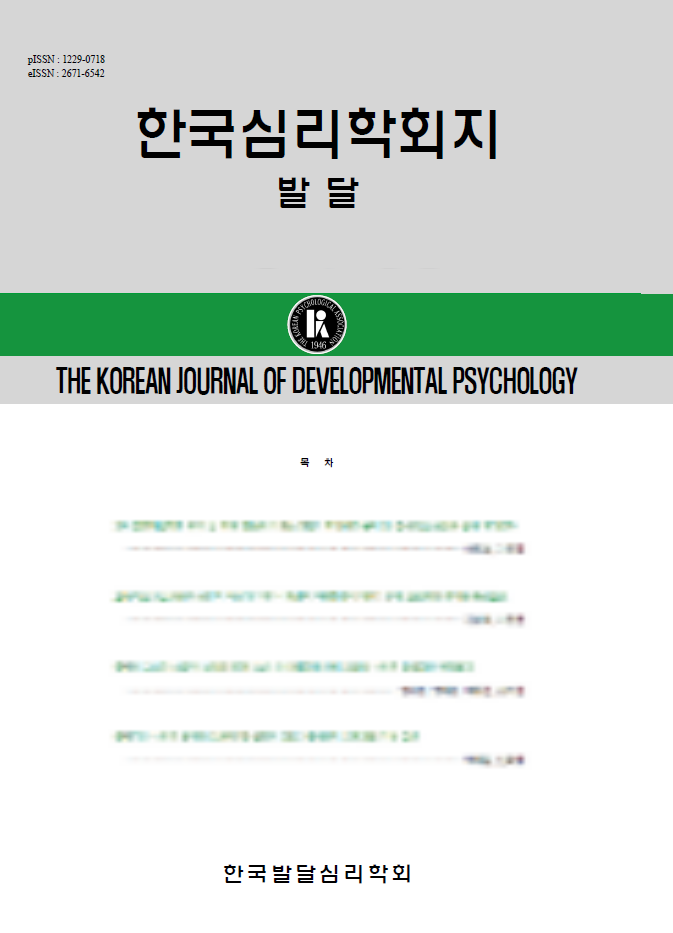open access
메뉴
open access
메뉴 ISSN : 1229-0718
ISSN : 1229-0718

상대방 말의 음성적 특성에서 정서를 파악하는 능력의 발달적 변화에 대해 연구하였다. 이를 위해 말의내용(중립적/기쁜/무서운)과 음성적 특성(기쁜 목소리/무서워하는 목소리)을 다양하게 변화시킨 말 자극을 초등 2학년과 4학년 및 대학생에게 제시하여 말한 사람의 정서를 판단하도록 하였다. 정서를 유발하지 않는 중립적인 내용을 기쁜 또는 무서워하는 음성적 특성의 목소리로 말한 자극에 대해서는 모든 연령집단 아동이 음성적 특성에 따라 정서 판단하였다. 이에 반해 말의 내용이 기쁘거나 무서운 내용일 경우에는 연령과 말의 내용, 그리고 음성적 특성과 내용의 일치성에 따라 차이가 있었다. 기쁜 내용의 말자극에서는 음성적 특성이 말의 내용과 일치하던 일치하지 않던, 모든 연령집단이 음성적 특성에 따라판단하였다. 그러나 무서운 내용의 말 자극에서는 연령에 따른 차이가 있었다. 2학년은 말의 내용과 음성적 특성이 일치할 때에 비해 일치하지 않을 때 말의 음성적 특성에 의해 정서를 판단한 정도가 더 낮았으나, 대학생은 반대로 일치하지 않을 때 더 높았다. 이는 말의 내용과 음성적 특성이 일치하지 않을경우 연령이 높아질수록 음성적 특성을 고려하여 정서를 판단함을 보여준다.
This study examined the developmental change in reading the emotional states from the voice tone of speech. Seven- and 9-year-old children and adults judged whether the speaker was happy or fearful from cues conveyed by the content and affective vocal tone of speech. When the emotionally neutral contents were uttered with happy or fearful voice tone, all three groups relied on voice tone. In contrast, when the contents of utterances were about happy or fearful situations, the judgments differed according to the two factors; the content of speech, and the congruity of information conveyed by the content and affective vocal tone of speech. In case of happy utterances, all three groups relied on voice tone regardless of the congruity of information conveyed by the two cues. In contrast, group differences had been found in case of fearful utterances: Seven-year-olds relied on the voice tone less in the incongruent condition than in the congruent condition, but adults relied on the voice tone more in the incongruent condition. The present results demonstrate that as children get older, they rely more on the voice tone when the two cues convey incongruent information about the emotional states of speaker.
곽동기 (1998). 영어와 한국어의 말의 운율체계비교 연구. 新羅大學校論文集, 46, 279-301.
김혜리, 구재선, 김경미, 양혜영, 정명숙, 최현옥,이수미 (2007). 학령기와 그 이후의 마음이해발달: 애매한 상황에서의 마음읽기 능력. 한국심리학회지: 발달, 20(1), 19-47.
이정현, 조경자, 박수진, 한광희, 김혜리(2007). 감성과학, 10(1), 113-125.
이호영 (1994). 한국어와 영어의 말의 운율. 대한음성학회 1994년도 2월 학술대회지, 54-65.
정찬섭, 오경자, 이일병, 변혜란 (1998). 감성 인터페이스 - 얼굴 표정의 인식 및 합성 모형. 1998년도 한국심리학회 동계연구세미나: 인지공학-인지심리학의 응용, 121-160.
Cooper, R. P., & Aslin, R. N. (1990). preference for infant-directed speech in the first month after birth. Child Development, 61, 1584- 1595.
Ekman, P., Friesen, W., (1971). Constants across cultures in the face emotion. Journal of Personality and Social Psychology, 17, 124-129.
Ekman, P. (2007). Emotion revealed: Recognizing faces and feelings to improve communication and emotional life. second Edition. New York: Henry Holt and Company, LLC.
Feldman, L. A. (1995). Valence focus and arousal focus: Individual differences in the structure of affective experience. Journal of Personality and Social Psychology, 69, 153-166.
Fernald, A. (1993). Approval and disapproval: Infant responsiveness to vocal affect in familiar and unfamiliar languages. Child Development, 64, 657-674.
Friend, M. (2000). Developmental changes in sensitivity to vocal paralanguage. Developmental science, 3, 148-162.
Friend, M., & Bryant, J. B. (2000). A developmental lexical bias in the interpretation of discrepant messages. Merrillpalmer Quarterly, 46, 342-369.
Golan, O., Baron-Cohen, S., Hill, J. J., & Golan. Y. (2006). The "reading the mind in films" task: complex emotion recognition in adults with and without autism spectrum conditions. Social Neroscience, 1, 111-123.
Golan, O., Baron-Cohen, S., Hill, J. J., & Rutherford, M. D. (2007). The 'Reading the mind in the voice' test-revised: a study of complex emotion recognition in adults with and without autism spectrum conditions. Journal of Autism and Developmental Disorder, 37, 1096-1106.
Happé, F. G. E. (1994). An advanced test of theory of mind: understanding of story characters' thougnts and feelings by abble autistic, mentally handicapped and normal children and adults. Journal of Autism and Developmental Disorders, 24, 129-154.
Happé, F. G. E., Winner, E., & Brownell, H.(1998). The Getting of Wisdom: Theory ofMind in Old Age. DevelopmentalPsychology, 34, 358-362.
Kleinman, J., Marciano, P. L., & Ault, R. L.(2001). Advanced theory of mind inhigh-functioning adults with autism. Journalof Autism and Developmental Disorder, 31,29-36.
Morton, J. B., & Trehub, S. (2001). Children's understanding of emotion in speech. Child development, 72, 834-843.
Morton, J. B., Trehub, S. E., & Zelazo, P. D.,(2003). Source if Inflexibility in 6-year-Old'Understanding of Emotion in Speech, ChildDevelopment, 74, 1857-1868.
Ohman, A., Flykt, A., & Esteves, F. (2001). Emotion drives attention: Detecting the snake in the grass. Journal of Experimental Psychology: General, 130, 466-478.
Rutherford, M. D., Baron-Cohen, S., & Wheelwright, S. (2002). Reading the mind in the voice: a study with normal adults and adults with asperger syndrome and high functioning autism. Journal of Autism and Developmental Disorder, 32, 189-194.
Scherer, K. R. (1986). Vocal affect expression: A review and a model for future research. Psychological Bulletin, 99, 143-165.
Solomon, D., & Ali, F. A. (1972). Age trends in the perception of verbal reinforcers. Developmental Psychology, 7, 238-243 .
Sorce, J. F., Emde, R. N., Campos, J. J., & Klinert, M. D. (1985). Maternal emotional signaling: Its effects on the visual cliff behavior of 1-year-olds. Developmental Psychology, 21, 195-200.
Svejda, M. J. (1981). The development of infant sensitivity to affective messages in the mother's voice. Dissertation Abstracts International, 42 (11), 4623B (University Microfilms No. 8209948).
